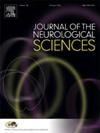基于任务的fMRI评估脑卒中后偏瘫上肢康复中rTMS对初级运动皮层的影响:一项系统综述
IF 3.2
3区 医学
Q1 CLINICAL NEUROLOGY
引用次数: 0
摘要
重复性经颅磁刺激(rTMS)传递到初级运动皮层(M1)是一种公认的促进中风后半瘫上肢恢复的介入方式。功能磁共振成像(fMRI)是一种可靠的技术,可用于研究脑卒中恢复的神经机制。本综述的目的是评估M1-rTMS对脑卒中后大脑的影响,通过任务型fMRI测量,并研究脑激活与M1-rTMS促进脑卒中后偏瘫上肢恢复之间的关系。方法检索2000年1月至2024年1月的spubmed、EMBASE、Web of Science和Cochrane Library。两名独立研究人员筛选了文献,提取了数据,并定性地总结了纳入研究的功能磁共振成像结果。结果本综述纳入了13项研究,涉及374例卒中后患者。在偏瘫的手部运动中,10项研究中有5项报告了低频rtms后同侧M1比对侧M1的激活增加。这些激活在受刺激的M1和感觉运动网络中都有表现。三项研究发现,脑活动向同侧M1侧化的增加与中风后运动能力的改善正相关,一项研究发现,双侧M1 - M1抑制的减少与运动能力的改善正相关。结论基于任务的fMRI扩展了rTMS对M1在脑卒中后半瘫上肢恢复中的调节作用。M1-rTMS的治疗机制与重建双半球平衡一致,与脑卒中后上肢恢复相关。本文章由计算机程序翻译,如有差异,请以英文原文为准。
Task-based fMRI assessment of rTMS over the primary motor cortex in poststroke hemiparetic upper extremity rehabilitation: A systematic review
Background
Repetitive transcranial magnetic stimulation (rTMS) delivered to the primary motor cortex (M1) is a well-established interventional modality promoting poststroke hemiparetic upper extremity recovery. Functional magnetic resonance imaging (fMRI) is a reliable technique that can be used to investigate the neural mechanism of stroke recovery. The objective of this review is to evaluate the impact of M1-rTMS on poststroke brains, measured by task-based fMRI, and to investigate the relationship between brain activation and poststroke hemiparetic upper extremity recovery facilitated by M1-rTMS.
Methods
PubMed, EMBASE, Web of Science, and the Cochrane Library were searched from Jan 2000 to Jan 2024. Two independent researchers screened the literature, extracted data, and qualitatively summarized the fMRI findings from the included studies.
Results
Thirteen studies involving 374 poststroke patients are included in this review. During hemiparetic hand movement, 5 out of 10 studies reported increased activation in the ipsilesional M1 following Low frequency-rTMS over the contralesional M1. These activations were represented in both the stimulated M1 and in the sensorimotor networks. Three studies found increased lateralization of brain activation towards the ipsilesional M1 to be positively correlated with motor improvements after stroke and one study found decreased bilateral M1–M1 inhibition to be positively correlated with improved motor performance.
Conclusions
Task-based fMRI extends the modulatory effect of rTMS over the M1 in poststroke hemiparetic upper extremity recovery. The treatment mechanism of M1-rTMS is in line with the re-establishment of bi-hemispheric balance, which is correlated with upper extremity recovery after stroke.
求助全文
通过发布文献求助,成功后即可免费获取论文全文。
去求助
来源期刊

Journal of the Neurological Sciences
医学-临床神经学
CiteScore
7.60
自引率
2.30%
发文量
313
审稿时长
22 days
期刊介绍:
The Journal of the Neurological Sciences provides a medium for the prompt publication of original articles in neurology and neuroscience from around the world. JNS places special emphasis on articles that: 1) provide guidance to clinicians around the world (Best Practices, Global Neurology); 2) report cutting-edge science related to neurology (Basic and Translational Sciences); 3) educate readers about relevant and practical clinical outcomes in neurology (Outcomes Research); and 4) summarize or editorialize the current state of the literature (Reviews, Commentaries, and Editorials).
JNS accepts most types of manuscripts for consideration including original research papers, short communications, reviews, book reviews, letters to the Editor, opinions and editorials. Topics considered will be from neurology-related fields that are of interest to practicing physicians around the world. Examples include neuromuscular diseases, demyelination, atrophies, dementia, neoplasms, infections, epilepsies, disturbances of consciousness, stroke and cerebral circulation, growth and development, plasticity and intermediary metabolism.
 求助内容:
求助内容: 应助结果提醒方式:
应助结果提醒方式:


